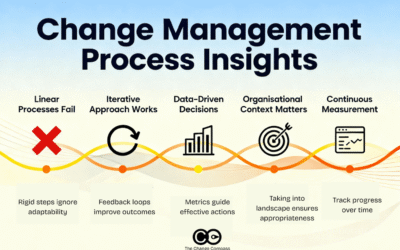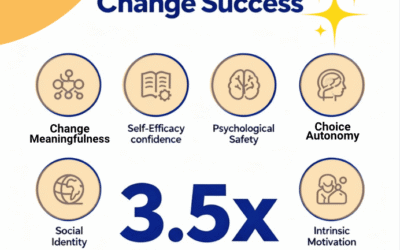Change management, much like peeling an onion, involves uncovering multiple layers before reaching the core. Each layer peeled back in the journey of planning and implementing change reveals new insights about the organization and the stakeholders impacted by the change. This process is essential to understanding the full scope of the change, adapting strategies accordingly, and ensuring successful implementation. By examining the various facets of an organization, such as leadership capability, operational practices, and cultural traits, we can better navigate the complexities of change management. Let’s explore the analogy of peeling an onion in change management and some practical insights for transforming change outcomes.
What is the peeling the onion protocol and how does it work?
The Peeling the Onion Protocol is a change management strategy that involves gradually uncovering layers of resistance within an organization. By systematically addressing concerns and facilitating open dialogue, this protocol fosters understanding and acceptance of change, ultimately leading to smoother transitions and enhanced collaboration among team members.
Peeling the layers – each layer reveals a different facet of the organisation and how they may or may not be conducive to supporting the change. Here are some ‘layers’ you may want to examine.
Leadership and Managerial Capability in Managing Change
Effective change management begins with strong leadership. Leaders and managers play a crucial role in guiding the organization through the transition. Peeling back this layer reveals whether leaders are equipped with the necessary skills, knowledge, and attitudes to drive change. It also highlights their ability to inspire and mobilize their teams, communicate the vision effectively, and manage resistance. Assessing leadership capability is fundamental, as inadequate leadership can hinder the entire change process.
Operational and Business Practices
The next layer involves examining the organization’s operational and business practices. This includes evaluating current workflows, processes, and systems to identify areas that may need adjustment or improvement. Understanding how daily operations align with the proposed changes helps in anticipating potential disruptions and devising strategies to minimize them. Are existing practices consistent with the end state of the change? Are existing practices consistent? (or NA?) Why or why not? This layer also involves identifying key performance indicators (KPIs) that can measure the success of the change initiatives (https://thechangecompass.com/how-to-manage-a-multitude-of-change-initiatives-including-enterprise-wide/).
Change Governance Practices and Structure
Change governance refers to the frameworks and structures in place to manage and oversee change initiatives. Having the right governance structure ensures that the right oversight and decision making is setup to steer the change to success. Peeling back this layer involves assessing the effectiveness of existing governance mechanisms, such as steering committees, decision-making protocols, and accountability structures. Strong change governance ensures that change initiatives are well-coordinated, resources are allocated appropriately, and progress is monitored consistently. Weak governance, on the other hand, can lead to confusion, misalignment, and failure to achieve desired outcomes.
Key questions to ask here include such as:
- Is there sufficient governance bodies in place at different levels of the organisation to support change?
- Are there too many governance bodies?
- Are decision-making processes clear and effective?
- Are the right stakeholders involved in the relevant decision-making areas?

Engagement Channels
Effective engagement is critical in change management. This is more than just communication. This layer focuses on the channels and methods used to engage with stakeholders throughout the change process. Evaluating engagement channels helps in understanding how information is disseminated, feedback is collected, and concerns are addressed. It also highlights the effectiveness of internal communications and the role of external communications in managing stakeholder expectations and perceptions. What channels are most effective for what audience groups? Are there any gaps for engaging with all groups of stakeholders? (beyond just blasting emails or messages).
Change Champion Network
Change champions are resignated individuals within the organization who advocate for and support the change initiatives. Peeling back this layer involves identifying and empowering these champions. It also includes assessing their influence, credibility, and ability to motivate others. A strong network of change champions can facilitate smoother transitions by promoting buy-in, addressing resistance, and reinforcing positive behaviors. With the right nurturing and experience, an organisation-wide change champion network can act to support a myriad of change initiatives.
System and Process Maturity
The maturity of systems and processes within an organization significantly impacts the success of change initiatives. This layer involves evaluating the current state of technological systems, process automation, and data management practices. Mature systems and processes provide a solid foundation for implementing changes efficiently and effectively. Conversely, immature systems may require significant upgrades or overhauls to support the desired changes.
Change Management Maturity
Change management maturity refers to the organization’s overall capability to manage change. Peeling back this layer involves assessing the maturity of change management practices, methodologies, and tools. Organizations with mature change management capabilities have established frameworks, experienced practitioners, and a culture that embraces change. In contrast, organizations with low maturity may struggle with inconsistencies, resistance, and a lack of structured approaches.
To read more about improving change management maturity visit our article – A Comprehensive Guide to Elevating Change Management Maturity.
Resources and Capacity
This layer examines the availability of resources and capacity to support change initiatives. It includes assessing the organization’s financial resources, human capital, and physical infrastructure. Adequate resources and capacity are essential for executing change plans, overcoming obstacles, and sustaining momentum. Insufficient resources can lead to delays, reduced quality, and increased stress on employees. This does not just include the resources required within the project itself, it points more to the impacted stakeholders and if they have the resources and capacity required to undergo the change.
Culture and Behavioral Traits
Organizational culture and behavioral traits play a significant role in how change is perceived and adopted. Peeling back this layer involves understanding the underlying values, beliefs, and behaviors that influence how employees respond to change. It also includes identifying cultural strengths that can be leveraged and cultural barriers that need to be addressed. A supportive culture fosters resilience, adaptability, and a positive attitude towards change.
Specifically:
- Do existing behaviours and practices support the change end state?
- Are there potentially inconsistent behaviours comparing the end state and the current state?
- Beyond the specific behaviours required in the change initiative itself, how are these in alignment with broader cultural practices?

Key Takeaways from the Onion Analogy in Change Management
1. Each Layer Needs to Be Peeled Before Another Layer Can Be Peeled
The process of discovering and understanding the complexities of change cannot be rushed. Each layer provides valuable insights and learning opportunities that prepare the organization for the next layer of discovery. Skipping layers or rushing through the process can lead to incomplete assessments, overlooked challenges, and ineffective solutions. Patience and persistence are crucial for a thorough and successful change management journey.
Assessing and understanding each layer can take time. Data, both quantitative and qualitative, may be required to truly understand what each layer means and how it implicates the change.
2. How the Onion Appears May Not Be What It Is at Its Core
Initial perceptions of the organization may not reflect its true state. It takes time and effort to uncover the deeper issues, strengths, and opportunities. This requires a willingness to look beyond surface-level indicators and delve into the core aspects of the organization. Attention to detail and a commitment to uncovering the truth are essential for developing accurate and effective change strategies.
For example:
- Are publically communicated and reinforced messages acted on?
- Do leaders practice what they preach?
- Do stakeholders commit to decisions already made? Or do they ignore it?
- Is there clear alignment between different layers of the organisation? How is this done?
3. You May Discover Rotten Parts That Need to Be Replaced
During the process of peeling back layers, you may encounter parts of the organization that are severely inadequate or dysfunctional. These “rotten” parts may need to be replaced or significantly improved before the change can proceed. This could involve overhauling critical capabilities, restructuring teams, or implementing new systems. Recognizing and addressing these issues promptly is essential for ensuring the overall health and success of the organization.
You may find, for example:
- Stakeholders that are adamant to block the change for various reasons
- Teams that simply do not have the right skills or attitude to transition to the required state
- Processes that are simply outdated or convoluted, so much that end state targets cannot be achieved
- Systems that are outdated and do not provide the right insights to support the end state
4. Different Types of Onions and Organizations
Just as there are different types of onions, organizations vary in size, complexity, and nature. Assessing the complexity of the change at the outset helps in determining the time, effort, and resources required to peel back the layers. A comprehensive understanding of the organization’s unique characteristics allows for tailored change management strategies that address specific needs and challenges.

Practical Steps for Applying the Onion Analogy in Change Management
Step 1: Initial Assessment and Planning
Begin by conducting a thorough initial assessment of the organization. This involves gathering data, engaging with key stakeholders, and understanding the current state of affairs. Develop a comprehensive change management plan that outlines the objectives, scope, and timelines for each layer of the onion. This plan should also identify key metrics for measuring success and mechanisms for tracking progress.
Step 2: Assess Leadership and Managerial Capability
Evaluate the capability of leaders and managers to drive change. This includes assessing their skills, experience, and attitudes towards change. Provide training and support where needed to enhance their ability to lead effectively. Strong leadership is foundational to the success of any change initiative.
Step 3: Examine Operational and Business Practices
Analyze current workflows, processes, and systems to identify areas that may require adjustment. Engage with employees at all levels to gather insights and understand potential bottlenecks. Develop strategies to streamline operations and ensure alignment with the change objectives.
Step 4: Review Change Governance Practices
Assess the existing governance structures and practices in place to manage change initiatives. Ensure that there are clear decision-making protocols, accountability mechanisms, and regular progress reviews. Strengthen governance frameworks as needed to support effective change management.
Step 5: Evaluate Engagement Channels
Review the channels and methods used to communicate with stakeholders. Ensure that there are effective mechanisms for disseminating information, collecting feedback, and addressing concerns. Enhance engagement strategies to foster transparency, trust, and collaboration.
Step 6: Identify and Empower Change Champions
Identify individuals within the organization who can serve as change champions. Empower them with the necessary tools, resources, and support to advocate for the change initiatives. Leverage their influence and credibility to promote buy-in and address resistance.
Step 7: Assess System and Process Maturity
Evaluate the maturity of technological systems and processes. Identify areas that require upgrades or improvements to support the change. Invest in the necessary infrastructure and tools to ensure seamless implementation.
Step 8: Assess Change Management Maturity
Conduct a maturity assessment of the organization’s change management capabilities. Identify gaps and areas for improvement. Develop and implement strategies to enhance change management practices, methodologies, and tools.
Step 9: Review Resources and Capacity
Evaluate the availability of resources and capacity to support the change initiatives. Ensure that there are adequate financial, human, and physical resources to execute the change plans. Address any resource constraints proactively to prevent delays and disruptions.
Step 10: Understand Culture and Behavioral Traits
Conduct a cultural assessment to understand the underlying values, beliefs, and behaviors that influence how employees respond to change. Identify cultural strengths that can be leveraged and barriers that need to be addressed. Develop strategies to foster a supportive culture that embraces change.
To read more about driving behavioural change check out The ultimate guide to behaviour change.
The analogy of peeling an onion provides a powerful framework for understanding and managing change within an organization. Each layer peeled back reveals new insights and learning opportunities that are essential for successful change management. By carefully examining the various facets of the organization, such as leadership capability, operational practices, and cultural traits, organizations can navigate the complexities of change more effectively.
Patience, persistence, and attention to detail are key to uncovering the true state of the organization and developing tailored strategies that address specific needs and challenges. Ultimately, the journey of peeling the onion in change management leads to a deeper understanding, better preparation, and more successful change outcomes.






